Exploring the Benefits of Fillet Welding in Fabrication: Economical Solutions for Diverse Industries
In the realm of manufacture, the utilization of fillet welding offers an engaging recommendation for markets seeking economical remedies without jeopardizing structural integrity. The advantages of fillet welding prolong past simple financial cost savings to incorporate enhanced architectural effectiveness, versatility throughout diverse industrial applications, and the guarantee of premium stamina and sturdiness. As we browse with the practical advantages that fillet welding offers, a much deeper understanding arises of how this welding strategy can reinvent fabrication processes across numerous fields.

Affordable Option for Construction
Fillet welding acts as a cost-effective solution in manufacture processes, offering both performance and resilience. This welding method entails signing up with 2 pieces of steel at an angle, creating a triangular cross-section. The simplicity of fillet welding makes it a popular choice in numerous industries, including building and construction, automotive, and production.
One of the crucial advantages of fillet welding is its capability to reduce material and labor expenses. By utilizing fillet welds rather of various other intricate joint styles, producers can conserve cash on products and manufacturing time. Additionally, fillet welding calls for marginal preparation contrasted to other welding methods, additionally decreasing construction costs.
Additionally, fillet welds supply superb architectural toughness, ensuring the longevity and longevity of the made parts. The triangular shape of the weld disperses tension a lot more uniformly, minimizing the probability of joint failure (Gauge Fillet Weld). This structural integrity not only improves the total high quality of the completed product but also reduces maintenance and repair work costs over time
Improved Architectural Effectiveness With Fillet Welding
Enhancing structural efficiency via the application of fillet welding techniques is a vital element of making sure optimal performance and sturdiness in fabricated frameworks. Fillet welding plays a crucial duty in improving architectural efficiency by effectively dispersing tons and stress and anxieties throughout the bonded joints. By producing a smooth transition between the connected components, fillet welds assist to improve the total stamina and security of the framework.
One of the substantial advantages of fillet welding in boosting architectural effectiveness is its capacity to join products of differing thicknesses. This adaptability enables the building of light-weight structures without endangering on stamina. In addition, the smooth profile of fillet welds lowers tension focus, which can help protect against premature failing of the welded joints.
Moreover, fillet welding enables the construction of intricate geometries with convenience, supplying developers with more freedom in producing ingenious and efficient structures. By enhancing the layout and positioning of fillet welds, engineers can take full advantage of the architectural efficiency of made components, eventually bring about cost savings and enhanced efficiency in varied markets.
Flexibility in Diverse Industry Applications
With its capacity to deal with a wide variety of product thicknesses and geometric intricacies, fillet welding stands as a functional manufacture technique that finds applications throughout diverse markets. One key location where fillet welding stands out remains in the manufacturing market, where it is used in the production of heavy equipment, tools, and architectural components. The automotive market additionally takes advantage of fillet welding, using it in the setting up of car structures, framework, and other vital frameworks. In the construction field, fillet welding plays an important function in joining steel beams, columns, and other structural elements. In addition, the aerospace sector counts on fillet welding for the fabrication of aircraft parts, making sure stamina and longevity in crucial parts. The oil and gas sector makes use of fillet welding in the building of pipelines, platforms, and storage space containers, where the robust welds offer stability and longevity to these frameworks. Generally, the flexibility of fillet welding makes it an important process in various sectors, providing cost-effective remedies for complex construction needs.

Superior Strength and Sturdiness
When thinking about welding techniques for fabricating frameworks that require outstanding strength and long life, the emphasis shifts in the direction of approaches that can consistently supply premium stamina and resilience. Fillet welding plays a critical great site role in accomplishing these characteristics due to its capability to supply substantial toughness by dispersing loads equally across the welded joint. This welding method creates a triangular cross-section that boosts the weld's resistance to different types of stress and anxiety, consisting of tension, compression, and shear pressures. Consequently, frameworks fabricated using fillet welds exhibit raised toughness and can stand up to substantial mechanical pressures without compromising their stability - Gauge Fillet Weld.
The premium stamina and longevity offered by fillet welding make it a suitable choice for applications in sectors such as construction, vehicle, aerospace, and production, where architectural integrity is vital. By utilizing fillet welds in fabrication, engineers and makers can guarantee that their items fulfill rigorous quality and safety requirements while maximizing cost-effectiveness and manufacturing performance. Essentially, the exceptional strength and long life supplied by fillet welding make it a recommended welding strategy for developing durable and sturdy frameworks throughout varied industries.
Practical Benefits of Fillet Welding
Provided the demonstrated exceptional strength and durability in welded joints, the sensible advantages of fillet welding prolong beyond structural honesty to include effectiveness and cost-effectiveness in fabrication processes. One essential functional advantage is the simpleness of fillet welds, which do not need costly or intricate tools to develop. This simplicity translates right into time savings throughout manufacture, as fillet welding can be swiftly applied in different positions without the need for intricate configurations. Furthermore, fillet welding allows for raised performance because of its flexibility in signing up with various sorts of thicknesses, forms, and materials. The flexibility of fillet welds makes them ideal for a large range of applications throughout diverse sectors, even more contributing to cost-effectiveness in making processes. The decreased demand for substantial surface preparation contrasted to various other welding methods minimizes material waste and decreases production downtime. Overall, the functional advantages of fillet welding make it a useful option for business looking for efficient and cost-effective solutions in fabrication.
Conclusion
Finally, fillet welding offers an economical option for fabrication, supplying improved structural efficiency, flexibility in diverse industry applications, premium stamina, click to find out more and longevity. The functional advantages of here are the findings fillet welding make it a favored option for various fabrication tasks throughout different markets. Its ability to efficiently join materials while keeping structural honesty makes it a beneficial strategy for making certain trusted and high-quality lead to welding applications.

In addition, fillet welding calls for minimal preparation contrasted to various other welding methods, better decreasing manufacture prices.

Offered the demonstrated remarkable strength and sturdiness in welded joints, the sensible advantages of fillet welding extend past structural honesty to incorporate efficiency and cost-effectiveness in construction procedures - Gauge Fillet Weld.In conclusion, fillet welding provides a cost-efficient service for construction, giving improved structural efficiency, versatility in varied sector applications, superior strength, and toughness